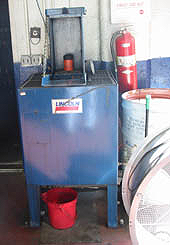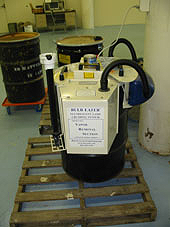 What is pollution prevention?
What is pollution prevention?
US EPA defines pollution prevention, or P2, as “source reduction” and other practices that reduce or eliminate the creation of pollutants. P2 is also referred to as source reduction, as it involves reducing the sources of pollution, rather than controlling or cleaning them up after pollutants have been generated. It relies on individual action – making education and awareness key to its effectiveness. Pollution prevention practices most often take the form of simple, individual actions that reduce the pollutants generated by a particular activity.
Activities at facilities like BWI Marshall and Martin State Airports often generate hazardous waste and other materials that have the capability to pollute the environment. Although the MAA and tenants have a number of programs in place to clean up spills or discharges before they have an opportunity to impact the environment, preventing pollution makes more economic and environmental sense then cleaning up after a spill has occurred.
 The federal Pollution Prevention Act (PPA) of 1990 established pollution prevention as the public policy of the United States. This act says that pollution should be prevented or reduced at the source, whenever feasible. When source reduction possibilities or recycling options are exhausted, pollutants should be recycled in an environmentally safe manner. Disposal or other release into the environment should occur only as a last resort and should be conducted in an environmentally safe manner.
The federal Pollution Prevention Act (PPA) of 1990 established pollution prevention as the public policy of the United States. This act says that pollution should be prevented or reduced at the source, whenever feasible. When source reduction possibilities or recycling options are exhausted, pollutants should be recycled in an environmentally safe manner. Disposal or other release into the environment should occur only as a last resort and should be conducted in an environmentally safe manner.
The PPA does not, however, mandate specific P2 measures. Specific P2 measures are mandated through regulations passed under such laws as the Clean Water Act (CWA) and the Resource Conservation Recovery Act (RCRA).
CWA: Regulations passed under the CWA require industrial facilities like BWI Marshall and Martin State Airports to prepare Stormwater Pollution Prevention Plans (SWPPPs) and to obtain National Pollutant Discharge Elimination System (NPDES) permits for stormwater. The MAA has obtained the required permit and has developed the SWPPP, and tenants are covered under these documents.
The NPDES permits for both BWI Marshall and Martin State Airports have requirements for pollution prevention and good housekeeping control measures, including:
- Maintenance of a clean, orderly facility
- Implementation of spill prevention and response
- Preventative maintenance (inspection, cleaning, testing) of stormwater management devices (oil/water separators, catch basins, etc.)
- Employee training
RCRA: Maryland and federal (RCRA) regulations require certain generators of hazardous waste to submit a biennial report of their waste generation activities during each even numbered year [for more information click here]. Among other information, the report must include a description of:
Efforts to reduce the volume and toxicity of waste generated
Changes in the volume and toxicity of waste actually achieved during the year in comparison to previous years.
Certain generators of hazardous waste must also certify on each hazardous waste manifest that they have a program in place to reduce the volume and toxicity of waste generated, to the degree that this has been determined to be economically practicable.
The federal regulations for biennial reporting and manifest certification statements apply only to Large Quantity Generators (LQGs) as defined under RCRA (i.e., generating more than 1,000 kilograms of hazardous waste in any calendar month).
Maryland rules apply to all hazardous waste generators who generate more than 100 kilograms of hazardous waste in a calendar month.
 In response to NPDES permit requirements, The MAA has formed a P2 team, consisting of MAA employees and tenant representatives. The P2 Team has identified and implemented a number of P2 measures applicable to tenants. These activities are encouraged by tenants to reduce the amount of material that needs to be disposed of as waste. These include use of:
In response to NPDES permit requirements, The MAA has formed a P2 team, consisting of MAA employees and tenant representatives. The P2 Team has identified and implemented a number of P2 measures applicable to tenants. These activities are encouraged by tenants to reduce the amount of material that needs to be disposed of as waste. These include use of:
- The recycling system for vehicle antifreeze
- A solvent recycling system
- An oil filter crusher at the BWI Marshall vehicle maintenance shop
- The fluorescent light bulb crusher and a paint can crusher
- Designated areas for vehicle and equipment washing
If you would like to become involved with the P2 Team, please contact Mark Williams at 410-859-7448.
What additional P2 activities can I implement to meet these regulatory requirements?
As the regulations do not specify the exact programs to implement there is a lot of flexibility in what tenants can develop. You can help prevent pollution from MAA activities by:
- Understanding what activities or processes in your workplace generate wastes or pollutants.
- Discussing with your supervisor/staff ideas for reducing or recycling these waste materials. In many cases, this will also save money on waste disposal costs.
- Following procedures and exercising care when using hazardous materials like solvents, degreasers, paint thinner, and cleaning solutions:
- Don’t use any more of the product than necessary
- Avoid spills
- Make sure that waste is properly disposed of
There are many activities at the airports for which pollution prevention measures can be implemented. Examples of these are identified below broken out by each activity:
Activity | Best Management Practices |
|---|---|
Aircraft Deicing |
|
Pavement Deicing |
|
Tenant Trash and Waste Disposal |
|
Aircraft and Ground Vehicle Fueling |
|
Aircraft and Ground Vehicle Maintenance |
|
Additional best management practices for various activities can be found through the stormwater section.
 Enforceable regulatory requirements for P2 are found in provisions of the Clean Water Act (CWA) and the Resource Conservation and Recovery Act (RCRA). BWI Marshall Airport’s NPDES permit for stormwater discharges is enforceable under the CWA, and identifies civil and criminal penalties for violations of the CWA or permit conditions. The penalties consist of substantial fines or imprisonment or both. Civil penalties for violations of the NPDES permit are subject to fines up to $27,500 per day for each violation and up to 15 years imprisonment.
Enforceable regulatory requirements for P2 are found in provisions of the Clean Water Act (CWA) and the Resource Conservation and Recovery Act (RCRA). BWI Marshall Airport’s NPDES permit for stormwater discharges is enforceable under the CWA, and identifies civil and criminal penalties for violations of the CWA or permit conditions. The penalties consist of substantial fines or imprisonment or both. Civil penalties for violations of the NPDES permit are subject to fines up to $27,500 per day for each violation and up to 15 years imprisonment.
Hazardous waste regulations, which include P2 requirements, are enforced by MDE. In addition, MDE may initiate civil actions or criminal prosecution that could result in fines of up to $250,000 and 15 years of imprisonment.
Although you may not be required under state or federal regulations to implement a P2 program, it makes good economic and environmental sense to implement P2 activities. Additionally, pollution prevention may help prevent discharges and spills, which would trigger other environmental regulations and could result in fines or penalties.
Both the Maryland Department of the Environment (MDE) and the Environmental Protection Agency (EPA) have developed extensive information resources to support and encourage P2 efforts. These resources can be accessed via the links below. They provide information about how to use less-hazardous materials for specific applications (such as parts cleaning) and other ways to reduce the amounts of waste from various types of activities.
Additional information:
